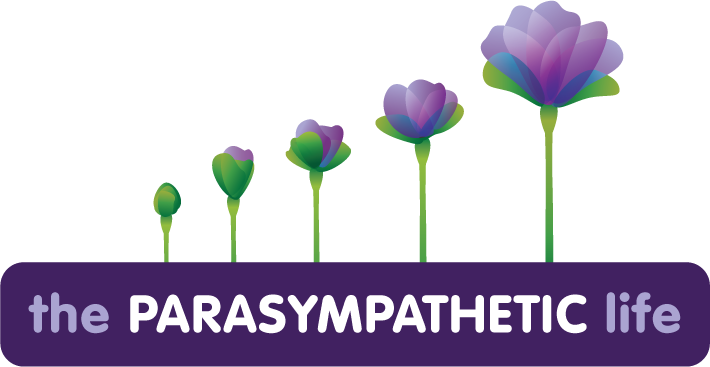Let’s Go to Vagus
Meet the left and right Vagus Nerve which innervates much of our viscera. Vagus means “Wanderer”, and you can see how early anatomists named it for its meandering path through the organs. Our vagus nerve is 80% sensory, meaning that it is primarily sending information from the organs back to the brain, adjusting swallowing, breathing, heartrate, blood pressure, intestinal peristaltic waves and more. Because the vagus is considered the main Parasympathetic nerve in the body, many Somatics leaders are discussing how to use the Vagus Nerve and Polyvagal Theory as a means to downregulate (calm) the Sympathetic Nervous System. As a longtime student of Visceral and Neural Manipulation, I learned techniques to mobilize the vagus or the fascia lining it so as to wake up its sensory motor loop and enhance its function. In CranioSacral Therapy, I learned to hold space for this nerve (and all the cranial nerves) to flow with the fluid fluctuations of cerebrospinal fluid indicating health in the nerve and organism. When needed, I had techniques to decompress the jugular foramen (the passageway in the skull through which this nerve travels) so as to ensure freedom of movement and lack of compression. In Somatic Experiencing, we applied aspects of Polyvagal Theory to activate the social engagement system* to recruit the vagus and other nerves that support nervous system regulation and balance so individuals can come out of chronic Fight or Flight. I also am familiar with the offerings of many holistic and integrative practitioners, such as Dr. Datis Kharrazian, Dr. Alan Christianson, Dr. Kelly Brogan, Dr. Axe, Dave Asprey and more who have shared techniques for stimulating this nerve and healing the gut which would support the vagus nerve to balance Parasympathetic tone.
After an injury left me deep into the stress response, none of the vagal techniques I knew, practitioners who used vagal techniques with me, as well as electronic vagal stimulators helped me shift out of my post traumatic stress reaction. I remained in my Sympathetic Nervous System. Only after learning Fajardo Method of Holistic Biomechanics™ did I finally start to come out of Fight or Flight. Our unconscious brain is designed to manage all of our bodily systems based on our location in the environment. When we remove one system to work with it (such as the nervous system, or one nerve) in order to induce a change, we are no longer operating within a holistic paradigm where all systems function together autonomically. Altering the nerve from the outside may cause a shift, but since the unconscious mind did not create it, it cannot recreate it. The nervous system’s perception of danger in the environment didn’t actually transform, it just got overruled by our reductionistic mindset (a mindset that is the manifestation of a brain in Sympathetic Nervous System dominance). Our body knows how to find homeostasis based on where we are, not how we feel. When we use a hack to impose our idea of what homeostasis feels like onto our bodies, our physiology shuts down and moves to the state that has been labelled “The Relaxation Response”. This passive stage of Fight or Flight is hypoactive and similar to hibernation or estivation (where desert animals bury themselves underground and their systems conserve energy so as to endure non-ideal weather conditions) and is not actually the Parasympathetic Nervous System. Read “My Meditation Journey” to learn more about this Conservation of Energy state of the Sympathetic Nervous System.
To experience moving towards Parasympathetic right now, try this FMHB™ Two Points of Awareness Observation. Notice the underneath side of your tongue. Get a sense of the shape and where the tip is touching. The underneath side of your tongue is your first point. Then notice the roof of your mouth right behind your upper front teeth. That is your second point. Observe these two places for 60 - 90 seconds and notice if anything changes with the position of your tongue or any other structures in your body. The changes you register are the result of your unconscious brain letting go of Fight or Flight reflexes and beginning to regulate not just the vagus, but your entire organism including your postural tone, your digestion, your respiration, your cardiac output, your hormones - every bodily system. Rather than you inducing a change, you give the nervous system information about your location, and your unconscious brain will govern all the physiological shifts that need to happen in the appropriate manner based on where you are and what you are doing.
If you would like more information or an experience of moving towards the very active state of Parasympathetic, where food is digested, fluids are pumped, tissues are repaired, sleep is regenerative, and all systems function in a balanced manner, please get in touch! We’ll go to vagus.
*As the name implies, the social engagement system recruits eye contact and communication to create a connection between people so that four cranial nerves that relate to the face, eyes, ears and voice can become activated. The goal is for this engagement to increase Parasympathetic tone (or decrease Sympathetic tone) and allow the client to perceive themselves as safe.

